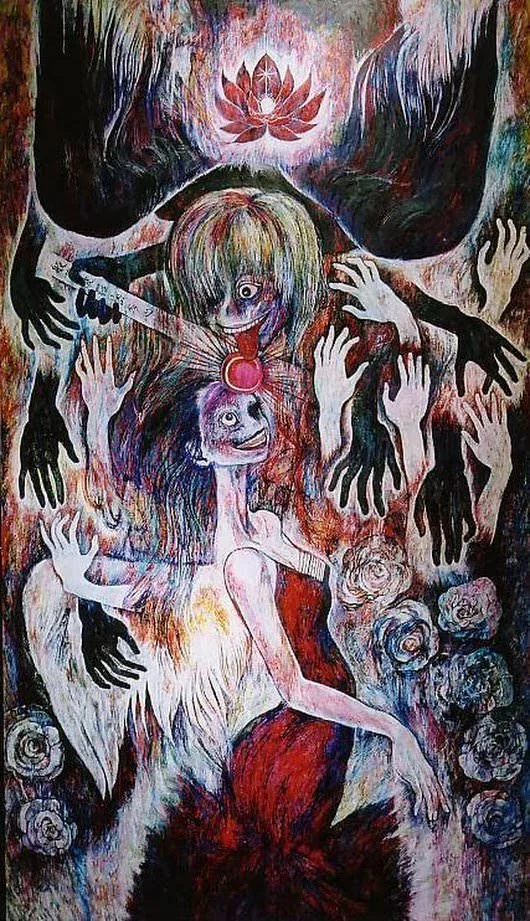Let me introduce you to the mysterious but unique Yuko Tatsushima, a rockstar Japanese painter.
Tatsushima-san is a master of combining oil and acrylic. Her artwork looks a little like watching a zombie unicorn tap dance with an acid rainbow. The vivid colors create a striking contrast for a rollercoaster of emotions. The art grabs viewers by the heartstrings and won’t let go.
What lies beneath these breathtaking displays of line and color, however, is a unique way of exploring human relationships and emotions. Her depictions of female figures show the harsh reality of sexual harassment, and intricate details leave viewers pondering life’s mysteries long after they leave the museum.
These works pack a punch. If you need your art fix in the form of an emotional powerhouse, check out Yuko Tatsushima’s work. Warning: Not for the faint of heart!
The 10 Darkest Paintings by the Japanese Yuko Tatsushushima

Her works address important topics like sexual harassment by adopting a forceful tone. Themes of dehumanization and religion are pervasive. The artist portrays women with torn gowns, signs of scarring and mutilation, and grotesque facial expressions. It’s as if the artist is wordlessly saying, “Enough is enough. Let’s talk about this; let’s make a change.”
Here are ten of her most iconic pieces, presented with commentary:
- Red Laugh.
- Spring Night Insect Dream
- I can’t be a bride anymore
- White Prison
- Ikueda Coffin
- Tsyumi Tsyumi
- Divine Comedy
- Misato’s Self-Determination
- Doll Rena
- King Mandala
1. Red Laugh

Yuko Tatsushima’s “Red Laugh” painting bubbled with youthful energy. Not necessarily positive, but a freshness and hallucinatory desire to escape something horrible.
The scratchy paint strokes in the background create perplexing, broken-glass-like patterns, intensifying the artwork’s tense and unsettling atmosphere. The figure in the painting has an unsettling smile and a long, stitched-up neck full of words she dares not speak.
Of course, the woman’s laughter is jarring and unnerving. Her pose and expression hint at madness and unbridled emotion. At the same time, there is something undeniably alluring about the scene.
The swirls of color create a sense of motion and chaotic activity, drawing the eye around the canvas.
“Red Laugh.”
Is it a manic-happy laugh, like finding out there’s an all-you-can-eat ice cream parlor nearby? Or is it a wicked laugh, like a villain plotting their next move in a superhero movie?
In the end, the riddle of this piece challenges us to explore the complexities of human emotions.
2. Spring Night Insect Dream

“Spring Night Insect Dream” is a captivating and intricate painting that draws the viewer into a world of natural beauty. At first glance, the picture appears to be a single figure composed against a backdrop of bright flowers. Upon closer inspection, it becomes apparent that many insects and other small creatures are hidden within the design, all interconnected and living in… harmony?
The painting’s title, “Spring Night Insect Dream,” suggests a sense of whimsy and morbid fantasy, capturing the dreamlike quality of the scene. The painting’s vibrant colors and intricate details, created through crisp, precise brush strokes, are a testament to Yuko Tatsushima’s technical prowess.
The painting comes alive with a splendid array of insects, each meticulously depicted in vibrant detail. You can almost feel the buzzing wings and the delicate, disjointed perambulation of arthropod limbs
From busy bees pollinating to adventurous specimens crawling through the leaves and even daredevil insects flying through the air, there’s no shortage of action and excitement in this artwork. Who knew insects could have such a thrilling social life?
Through this piece, Yuko Tsushima reminds us of the wonder and magic that can be found even in the smallest and least noticed creatures and the interconnectedness of all living beings…even in decay.
3. I can’t Be a Bride Anymore

This painting shows a woman with her eyes wide open, conveying the message of anger, strength, and boldness in the face of adversity. The artwork reflects the woman’s intensity, as her gaze is sharp and focused. She is standing upright, with confidence radiating from her posture, and her stance personifies her unwillingness to bow down to oppression or injustice.
Her dress is hitched up to the groin, implied by the horizontal scribbles that draw our eye to an intense redness in the center of the painting. Of course, it’s understood that this symbolizes the aftermath of her abuse. She can no longer be a bride because the rights of her bridegroom have been stolen by another. And yet she faces forward.
Although her paintings lack the finesse of ukiyo-e’s flowing lines, Tatsushima’s status as a Japanese artist is clear in the figure’s outfit: nearly exposed breasts framed by a white yukata and black obi.
4. White Prison

Yuko Tatsushima’s “White Prison” painting is a chilling work of art. At the center of the painting is a pale figure dressed in a torn gown with lacerations and cracks on her skin. The figure’s clouded white eyes stare blankly off the canvas, creating an eerie feeling that she is physically there, but not fully present. This is typical of trauma victims who experience an out-of-body sensation as a way to cope.
The background of the painting is beautifully shaded with deep decorations that enhance the painting’s dramatic quality. The figure seems to transform into something sinister and demonic while conveying an innocent vulnerability through its posture and body language.
The painting captures the sense of hopelessness and despair that are palpable through the haunting depiction of a tortured figure. The figure’s ghostly face evokes a feeling of sadness and loss. Additionally, the figure’s right arm further dehumanizes her. The viewer is left with the impression that the arm has been replaced with something artificial and lifeless, the arm of a ball-joint doll.
Overall, Yuko Tatsushima’s “White Prison” presents the image of a suffering figure that is both ugly and hauntingly beautiful.
5. Ikueda Coffin

The painting “Ikueda Coffin” by Yuko Tatsushima portrays a funeral scene filled with overwhelming despair. The artwork features three mournful figures, each with individual responses: anger, sadness, overwhelming disbelief.
Their faces convey grief, confusion, remorse, and horror. Behind them, four other somber figures in black overlook the scene with a ghostly presence. They are observing from afar. Among them, a vibrant rose stands in offering. Just another symbol, another onlooker with sentiment but no power, offered by a disembodied hand. This artwork portrays a powerful message that strongly resonates with the catastrophic and heartbreaking consequences of lives lost too early.
The impact of death is undeniably crystal clear, mainly conveyed through the wide-eyed figure in the painting. This figure captures the struggle of grappling with acceptance and the overwhelming grief that follows losing a loved one. With its powerful portrayal of grief and mourning, “Ikueda Coffin” is made even more profound by the expression on the corpse. Her eyes are not closed in peaceful repose, her mouth not slight. Rather, she is locked in an eternal grimace.
Overall, the “Ikueda Coffin” is a profoundly moving artwork highlighting the struggles many Japanese people face due to financial hardship. The painting underscores the importance of societal support and the need for compassion, empathy, and understanding toward others in difficult times.
6. Tsyumi Tsyumi

Another notable work is “Tsyumi Tsyumi”. This work, a modified doll, depicts a young girl whose eyes are filled with fear and vulnerability. The artist’s deliberate inclusion of scratches and wounds on the girl’s private parts is a stark reminder of the violations that victims of sexual harassment endure. By focusing on the innocence and vulnerability of the subject, Tatsushima brings attention to the devastating impact of such heinous acts.
“Tsyumi Tsyumi,” presents a striking depiction of a sensitive subject: the suffering of children. Bright sunflowers evoke youth and warmth, a stark contrast to the pallid complexion and dark, coagulated blood of the doll. While some viewers may find it offensive or disturbing, it is crucial to recognize the painting’s intent: to confront societal issues, spark empathy, and encourage conversations surrounding the mistreatment of children. The motif of the ball-jointed doll is especially poignant here. Tatsushima’s dark artistic style is often expressed through these dolls, which are a distinctly “adult” take on the classic children’s toy. They feature stylized, often childlike proportions, inherently a symbol of the adult mind’s fetishization and dehumanization of the child’s form.
7. Divine Comedy

‘Divine Comedy’ is one of the famous paintings by Yuko Tatsushima that has captivated audiences with its evocative and otherworldly essence.
The painting depicts adivine journey, symbolizing the path the soul must take to reach the realm of the sacred. It also calls back to metaphors for orgasm and dominance in relationships. The male figure reaches down from a lofty place, probably his own idea of heaven, to grasp at the female figure below. Seen upside down. this painting could easily be interpreted as hands reaching up from hell.
Interestingly, both figures feature angelic wings. A Buddhist icon, the lotus, is also highly visible, commenting on the religious and social whitewashing of sexual violence and its relation to enlightenment. The male-like angel figure is all hands, offering salvation to the woman below. His black wings tell a different story.
Although the meaning of the painting might not be immediately apparent, the artwork’s abstractness is intentional, only revealing its message to those who take the time to look more carefully.
Divine Comedy presents a powerful message regarding the individual’s journey towards enlightenment and spiritual transcendence, especially with respect to gender and sex. The painting’s complexity and abstractness contribute to its enigmatic qualities, inviting viewers to look beyond the surface and consider multiple interpretations of the artwork. Although it is less objective than her other paintings, Divine Comedy stands out as an awe-inspiring piece of art that encourages deep contemplation, reflection, and introspection.
8. Misato’s Self-Determination

‘Misato’s Self-Determination’ is a thought-provoking artwork that features a young girl lying down. The painting represents self-determination, which focuses on individuals’ right to control their lives and decide for themselves. The young girl in the picture appears weak and helpless. She is lying down, vulnerable, and seemingly unable to move or take action. From her mouth, we see a stream of pharmaceuticals. While Tatsushima’s usual paintings feature blood red, this figure’s veins run blue and cold, her body poisoned.
There is evidence of seeking help in the scars on her arms; her mouth is open as if to speak and cry out. We cannot know if she regrets the decision she has made, only that it was hers to make.
This work stands in stark contrast to the emotions in I Can’t be a Bride Anymore. The distant, standing, composed figure which has resigned itself is replaced here. The girl lies in a grotesque close-up, contorted and out of control, despite her desperate act to reclaim her life by taking it.
Yuko Tatsushima’s dark painting, Misato’s Self Determination, raises important questions about individual autonomy and control. The painting ultimately encourages viewers to reflect on their own experiences with self-determination and the challenges that can come with trying to assert control over their own lives.
9. Doll Rena

Yuko Tatsushima’s painting ‘Doll Rena’ revisits the doll as the artwork’s subject matter. The doll is a powerful symbol for the artist to explore femininity, childhood, and memory themes. On the other hand, using dolls can remind us of a sexist and patriarchal culture that perpetuates the objectification of women.
In the case of ‘Doll Renna,’ the doll appears lifeless and discarded, lying on a rough surface with a distressed background and scarred body. Perhaps it makes a statement about loss of innocence, or plain violence.
Tatsushima consistently uses the imagery of dolls to comment on how women have been cast aside. They also tie back to life in a society where aging and beauty are valued more than wisdom and knowledge.
‘Doll Rena’ is a powerful three-dimensional symbol of female identity.
10. King Mandala

King Mandala represents a departure in the artist’s subject matter. Instead of her usual tortured women, this dark painting by Tatsushima depicts a man, surrounded by pseudo-religious iconography. Here, as in Divine Comedy, the man is given a type of dark, metaphysical magic. demonic eyes paint his forearms and surround him. Warped crosses once again explore the dialogue between religion and rape culture. A floating, otherworldly smile and shadowed face give the sense that perhaps he is possessed by these creatures and not fully in control of his ghastly actions.
The figure has a pallid white chest- still human, but frail. His heart is framed by the implications of a byzantine halo. This speaks to the inherent purity of humanity, but its shape has been completely distorted into a smudge. “Blood” smudges often come up in Tatsushima’s works as the source of injury. It’s worth noting that a man’s wound is in his heart and not the groin. What could this say about Tatsushima’s own opinion?
—
I hope you enjoyed this article about the ten most haunting paintings by the talented Yuko Tatsushushima. Really, it’s better if you didn’t enjoy it. Instead, hopefully you gained some insight into the mind of a great artist and Japanese woman. If you want to discover more interesting artwork, check out this blog post about the 30 most popular Japanese artists.










